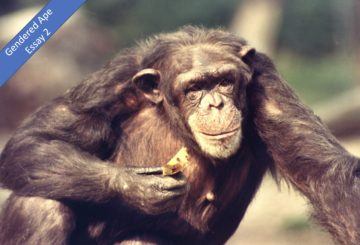Editor’s Note: Frans de Waal’s new book, Different: Gender Through the Eyes of a Primatologist, has generated some controversy and misunderstanding. He will address these issues in a series of short essays which will be published at 3QD and can all be seen in one place here. More comments on these essays can also be seen at Frans de Waal’s Facebook page.
by Frans de Waal

Short answer: No.
Long answer: Physical dominance is not the same as power and leadership.
Photograph: For over forty years, Mama was the alpha female of the large chimpanzee colony at Burgers’ Zoo. Portrait by Frans de Waal.
A century ago, the London Zoo put about one hundred hamadryas baboons together in the wrong sex ratio. Over 90% of the monkeys were male. They fought for years, and by the end the females had died as well as most of the males. The scientist in charge, Solly Zuckerman, who was quite prominent (Fellow of the Royal Society), popularized this unmitigated disaster. In the primates, he claimed, males rule brutally and supremely. Females have no say whatsoever. His observations hinted, he felt, at the origin of human society. Repeated over and over by others, this view became mainstream even though we, primatologists, wisely don’t mention Zuckerman much anymore. Too embarrassing!
The male supremacy view still holds in the public mind, though, such as in the 2002 book “King of the Mountain” by American psychiatrist Arnold Ludwig: “Most humans have been socially, psychologically, and biologically programmed with the need for a single dominant male figure to govern their communal lives. And this programming corresponds closely to how almost all anthropoid primate societies are run.”
This statement resembles Sigmund Freud’s reconstruction of the first human family as a “primal horde” around an overbearing father figure.
There is little support for the notion of the obligatory male overlord, however.
The baboon study at its origin concerned a species that is not particularly close to us. We belong to the same small family as the apes (large tail-less primates), not monkeys like baboons. Moreover, the hamadryas baboon has a huge size and weaponry difference between the sexes, and its males are exceptionally possessive.
Studying our next of kin, the great apes, offers a more nuanced, less patriarchal picture. Our two closest relatives, chimpanzees and bonobos, show a moderate size difference between the sexes, more in the human range. They offer a study in contrast, with chimpanzees being male-dominated, territorial, and violent, and bonobos being female-dominated, erotic, and pacific. Until now, there are no confirmed observations of one bonobo killing another but many such observations for chimpanzees. The bonobos’ tight sisterhood ensures that the alpha individual is always female. This is true for all captive colonies as well as for bonobos in the wild.
Yet, not everyone is thrilled to have bonobos in the family tree. Once, after a lecture for a German audience about the power of bonobo females, an older male professor stood up and barked in an almost accusatory tone, “What’s wrong with those males?!” While chimpanzees are favored as ancestral models by many anthropologists, due to the traditional emphasis on brotherhood and warfare in human evolutionary scenarios, and while feminists admire the gynarchy of bonobos, it’s good to realize that in terms of DNA both apes are exactly equally close to us. There is really no need to choose: they are both relevant for the reconstruction of human evolution.
The idea that males are more hierarchical than females, commonly heard in relation to human society, surprises any biologist. All female animals compete over rank and privileges, establish social hierarchies, and have an alpha female at the top.* Remember, the term “pecking order” derives from hens, not roosters.
Mama, the impressive alpha female of the world’s largest zoo colony of chimpanzees, may not have physically dominated any grown males, she enjoyed considerable political power. Power is the ability to decide group processes. In this regard, Mama was absolutely central. She was alpha for forty years, respected in this position even when she was nearly blind and could barely walk anymore. Male alphas came and went during her long reign, but every one of them needed her support to have a chance at the top spot. Mama’s capacity to rally female allies made her an indispensable player. She was the most groomed individual of the colony, and no male would get it into his head to ignore or abuse her.
Confusion about gender relations in primates stems from the false notion that animals are ruled by the “law of the strongest.” We have been taught that everything boils down to combat, which advantages males. Physical prowess does offer benefits, but primate societies are characterized by coalitions. Bonobo females, for example, are smaller than males and cannot individually dominate them. Their actual dominance is a collective one thanks to sisterly solidarity.
My first book “Chimpanzee Politics” (1982) detailed how coalitions work. Who rules the community is decided by networking, kinship, friendships, and strategic partnerships. This means that the smallest male may become alpha provided he has the right buddies and/or female support. It also means that females exert real power and that female leadership is not hard to find. In many primates, I estimate the social influence of the typical alpha female to be on a par with that of the typical alpha male.
FURTHER READING
* Alpha indicates the top of the social pyramid, usually divided into one for males and one for females since status competition is overwhelmingly within-gender. The term “alpha” does not refer to a personality type. Each group has one alpha of each gender.
On bonobo society: https://www.scientificamerican.com/article/bonobo-sex-and-society-2006-06/
On the unfortunate baboon bloodbath: https://priceonomics.com/the-massacre-at-monkey-hill/
For further details and references to the literature, read “Different: Gender Through the Eyes of a Primatologist” (Norton, 2022). A video about the book can be seen here: https://fb.watch/ffbauZBzNb/
